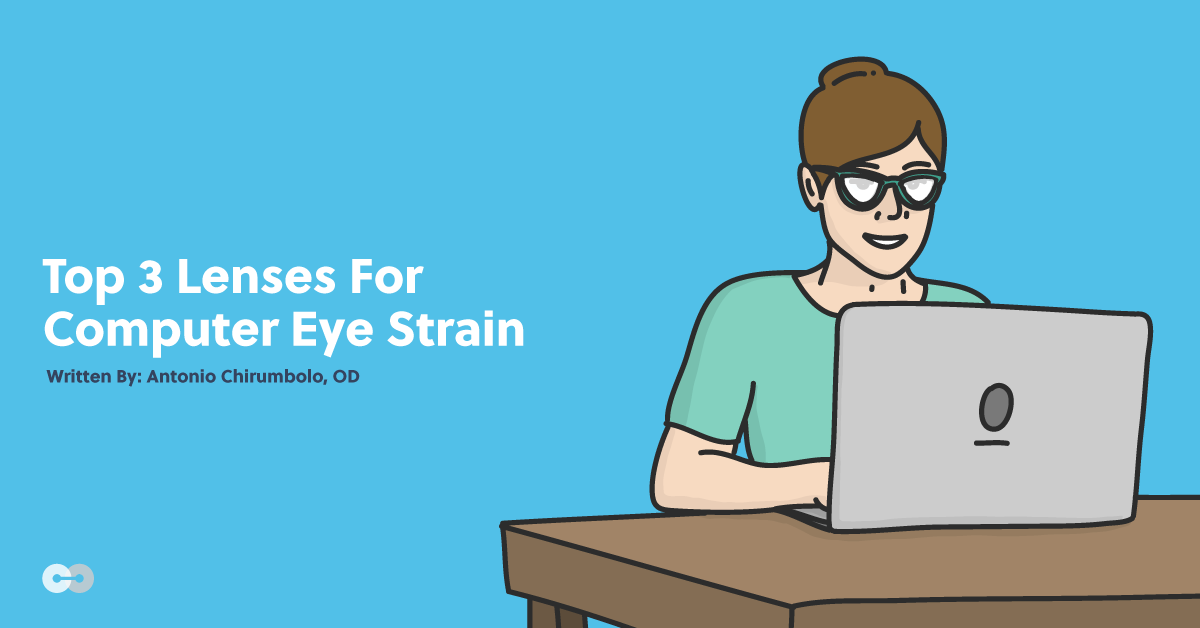Let’s face it, most of us spend a lot of time on computers every day. Whether for work, play, or everything in between, these screens can cause our eyes to get fatigued, cause headaches, and make work difficult. When patients bring this up, here are my go-to recommendations for protection of their eyes as well as reduction in computer eye strain.
Before we get to specific lens designs that I recommend, here are some environmental factors that cannot be ignored. When my patients and friends experience computer eye strain, I first always mention making some modifications to the screen itself. Usually, that comes in the form of a blue-blocking filter for their device such asNight Shift on Apple products. F.lux is a free downloadable blue-blocking filter that adjusts blue light according to the time of day to keep in sync with natural circadian rhythms. Iris Tech is another program where patients can not only adjust the amount of blue light being emitted from their screen but also adjust the flicker frequency of the computer which some people can be very sensitive to.
And of course, there are basic visual hygiene techniques like the 20-20-20 rule.
Here are my recommendations when it comes to prescribing lenses for computer eye strain.
1. Pre-presbyopic computer eye strain
More and more our non-presbyopic patients are coming in with near complaints. This warrants a careful exam, looking for latent hyperopia, accommodative, and phoria testing. For those patients who need more plus at near than they will accept in their distance Rx, I generally utilize near-variable focus lenses. I find these lenses can help reduce eye strain with prolonged screen time usage because of the built-in area of accommodative relief.
Because this is not a progressive lens, you don’t have to worry about narrow corridor issues that sometimes make Progressive Addition Lenses (PALs) difficult for prolonged near work. Many lens options offer a range of add powers that can be selected from depending on the patient’s age and symptoms.
Helpful tips:
*Measure a seg height at the pupil center with patient sitting in a natural position.
**Keep in mind that even small Rx’s can make a big difference for these patients with near complaints.
2. Presbyopic computer eye strain solutions:
Try out these solutions for presbyopic computer eye strain.
Tact/computer PALs
You may have a patient who wears either over the counter (OTC) readers for their computer work but has to remove them for walking around the office or has a traditional PAL but feels they don’t have enough reading area for computer use. In these cases, I recommend computer-specific progressive lenses.
These lenses have a wider computer or mid-range distance viewing area compared to a traditional PAL. The distance viewing area is meant for seeing across a room, perfect for an office setting or seeing a screen during a meeting. This means that someone who is used to wearing OTC readers wouldn’t have to take their glasses off for walking around the office. Additionally it solves the problem of needing to see both computers when referencing papers on a desk.
If you want to stick to a traditional progressive lens option, an excellent lens is the Varilux® X Series™ lens. This lens was designed for the modern spectacle lens-wearing patient. Utilizing Xtend™ Technology, this lens maximizes the range of sharp vision needed at arm’s length which is perfect for those patients needing clear comfortable vision not only at distance, but particularly at near and intermediate ranges.
Computer bifocals
I work in a community health center where cost is a concern for many of our patients. For that reason, and for patients who have been unsuccessful with PALs in the past, I will still sometimes recommend a lined computer bifocal for desktop computer range especially when someone works with data entry or does not have enough accommodative range to see the computer and papers that may sit on their desk with one single Rx. Just because technology has advanced a lot, sometimes going back to the basics is all our patients need.
Multifocal contact lenses
Many patients who haven’t needed glasses all their lives, those who hit 40 and need OTC readers, still don’t really like to use glasses. When they then start to need distance correction, or start to need one pair of glasses for reading, another for computer and still have trouble seeing signs while they drive, they may be more inclined to jump to multifocal contact lenses over progressive lenses.
These patients are often very motivated to avoid glasses! Many patients ask about LASIK when they start having near visual problems, however what they mean is that they don’t want to wear glasses. These patients can be great candidates for recommending multifocal contacts. There are plenty of multifocals to choose from in all the different wearing modalities.
Manage dry eye issues before fitting patients in contact lenses since prolonged computer use may make these fits more challenging.
Given all the options available to us as optometrists, we have plenty of options to meet all our patients' visual demands keeping in mind that it’s not unreasonable that they may need more than one pair of glasses to satisfy all their vision needs.
